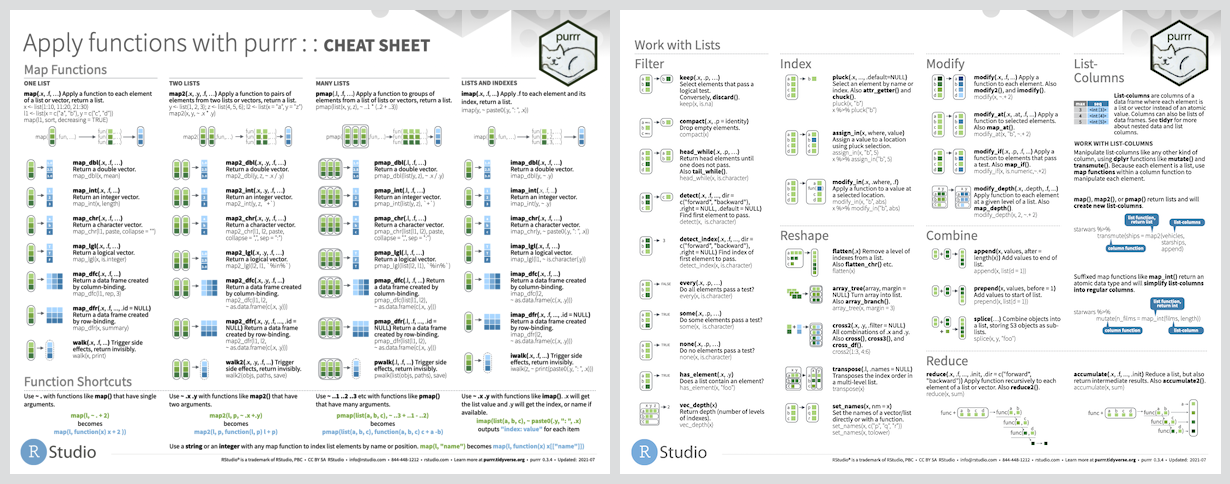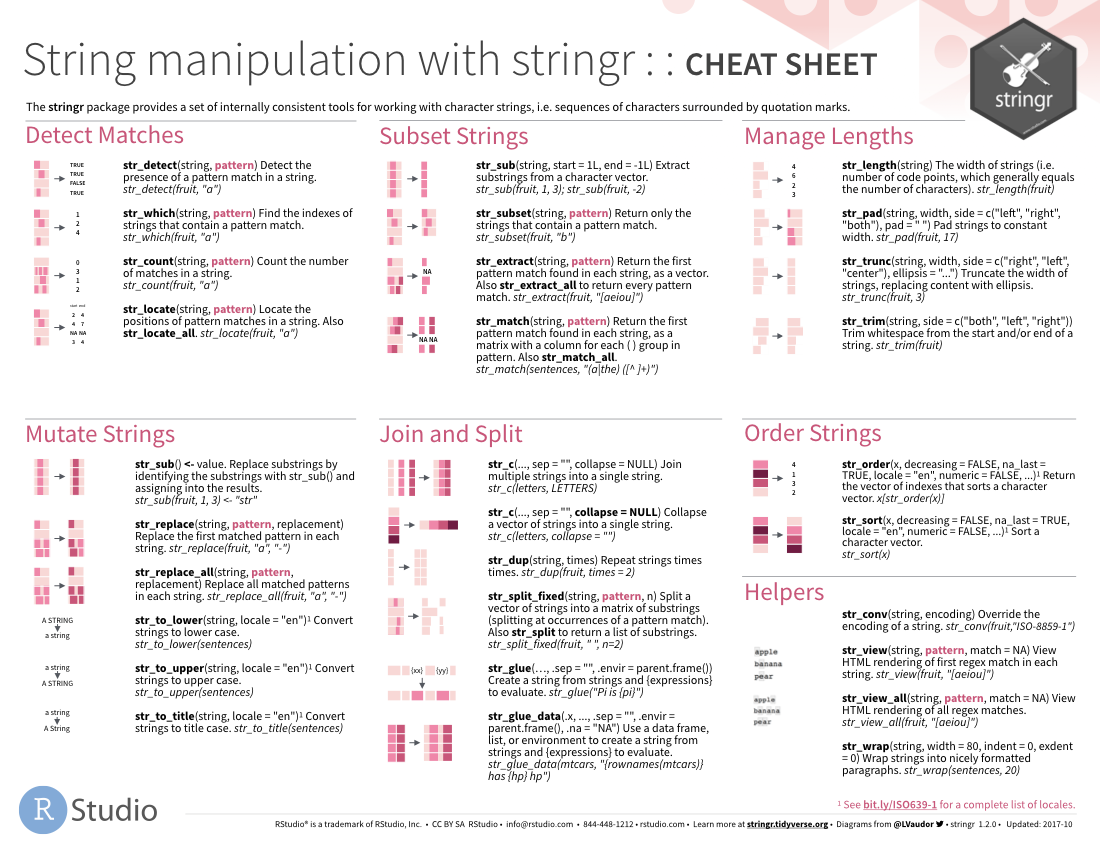Flashcards#
- R Functions Cheat Sheet Worksheet
- R Function Cheat Sheet Pdf
- R String Functions Cheat Sheet
- Basic R Syntax Cheat Sheet
I suggest making your own flashcards to study, but if you don’t want to you can use my flashcard deck here.
The examples use the traditional built-in R data sets (such as the iris data, used to create the neural network above), so there's unfortunately not much of a 'big data' aspect to the reference card. But if you're just getting started with prediction and classification models in R, this cheat sheet is a useful guide.
A function is just like a function in programming. It takes an input, performs some maths on it, then outputs the result.
The syntax of a function is f(x) = 2 * x. This means given x, the function will return 2*x.
- Almost all R functions will accept things passed to them in dollar sign syntax. The formula syntax, used by modeling functions like lm, lattice graphics, and mosaic summary statistics. It uses the tilde to connect a response variable and one (or many) predictors. Many base R functions will accept formula syntax.
- R Cheat Sheet: Applying functions. R Cheat Sheet: Applying functions. Apply(x,index,function) lapply(x,function) sapply(x,function) tapply(x,y,function).
- The data.table R Package Cheat Sheet June 8th, 2017 The data.table cheat sheet helps you master the syntax of this R package, and helps you to do data manipulations.
A function cannot have more than one output if given a single input. However, multiple inputs can lead to the same output.
Functions can be written in two ways, either f(x) = 2 * x or f: R→ Rwhich defines the input and output to be real numbers.

Domain, Codomain, Range#
Let function f(x) = 2x. The set, x, is the Domain; the range of all possible inputs. The set 2x is the codomain. The values produced by the function is the range.
In other syntax, f: A → B. A is called the domain, B is the **co-domain **and the **range **of f(A) is F(A) = {f(x) | x ∈ A}

Finding the domain of a function#
It is best to show an example of how to find the domain of a function.
f(x) = sqrt(2x-8)We know that the domain of a function is the set of all possible inputs into a function. We know that the above function is only defined when it’s taking the square root of a non-negative number so it’s only going to be defined when:2x-8 ≥ 0.Now this is a simple algebraic problem to find x.2x ≥ 8x ≥ 4So the domain here is the set of all real numbers ≥ 4.
Sometimes it is easier to find what cannot be in the domain than to find every item in the domain.
Given the function f(x) = 2/x-3, let’s try find the range.
Is there anything that X CANNOT be? Yes! If X is 0 it would cause an error as you cannot divide by 0!
Types of functions#
Label the left hand set A and the right hand set B and ignore the lines.
A has many B#
Not a function, because function inputs cannot map to more than one output.
B can have many A#
It is a function because a single output can be produced from different inputs.
B can’t have many A (Injective)#
Not all outputs of B can be produced by A.
Every B has some A (Surjective)#
Every output in B has at least one input in A, sometimes more.
A to B, perfectly (Bijective)#
Bijective is the combination of injective and surjective. Every A matches perfectly to an output.https://www.mathsisfun.com/sets/injective-surjective-bijective.html
Cardinality of sets#
The cardinality of a set is how many items are in the set, denoted as |a|
Powersets#
The powerset is the set containing every single subset of set A, where A is any set. The powerset of a = {1, 2, 3} is:
Pow(A)= { {1}, {2}, {3}, {1,2}, {1,3}, {2, 3}, {1, 2, 3}, {Ø} }
The cardinality of a power set is always 2^n where n is |a|. The same cardinality rule applies to bit vector sets.
Infinite sets#
Infinite sets can also be bijective, injective or surjective.
Uncountable sets#
There exists sets that are not countable, such as Cantor’s set derived from Cantor’s diagonal argument.
The Pigeon Hole Principle#
The Pigeon Hole Principle states that if |A| > |B| then at least one value of F occurs more than once.
In other words, if there are N holes and we have N+1 pigeon then 2 pigeons must occupy the same hole.
Flashcards#
I suggest making your own flashcards to study, but if you don’t want to you can use my flashcard deck here.
A function is just like a function in programming. It takes an input, performs some maths on it, then outputs the result.
The syntax of a function is f(x) = 2 * x. This means given x, the function will return 2*x.
A function cannot have more than one output if given a single input. However, multiple inputs can lead to the same output.
Functions can be written in two ways, either f(x) = 2 * x or f: R→ Rwhich defines the input and output to be real numbers.
Domain, Codomain, Range#
Let function f(x) = 2x. The set, x, is the Domain; the range of all possible inputs. The set 2x is the codomain. The values produced by the function is the range.
In other syntax, f: A → B. A is called the domain, B is the **co-domain **and the **range **of f(A) is F(A) = {f(x) | x ∈ A}
Finding the domain of a function#
It is best to show an example of how to find the domain of a function.
f(x) = sqrt(2x-8)We know that the domain of a function is the set of all possible inputs into a function. We know that the above function is only defined when it’s taking the square root of a non-negative number so it’s only going to be defined when:2x-8 ≥ 0.Now this is a simple algebraic problem to find x.2x ≥ 8x ≥ 4So the domain here is the set of all real numbers ≥ 4.
Sometimes it is easier to find what cannot be in the domain than to find every item in the domain.
Given the function f(x) = 2/x-3, let’s try find the range.

Is there anything that X CANNOT be? Yes! If X is 0 it would cause an error as you cannot divide by 0!
Types of functions#
Label the left hand set A and the right hand set B and ignore the lines.
A has many B#
Not a function, because function inputs cannot map to more than one output.
B can have many A#
It is a function because a single output can be produced from different inputs.

B can’t have many A (Injective)#
Not all outputs of B can be produced by A.
Every B has some A (Surjective)#
Every output in B has at least one input in A, sometimes more.
A to B, perfectly (Bijective)#
Bijective is the combination of injective and surjective. Every A matches perfectly to an output.https://www.mathsisfun.com/sets/injective-surjective-bijective.html
Cardinality of sets#
The cardinality of a set is how many items are in the set, denoted as |a|
Powersets#
The powerset is the set containing every single subset of set A, where A is any set. The powerset of a = {1, 2, 3} is:
R Functions Cheat Sheet Worksheet
Pow(A)= { {1}, {2}, {3}, {1,2}, {1,3}, {2, 3}, {1, 2, 3}, {Ø} }
The cardinality of a power set is always 2^n where n is |a|. The same cardinality rule applies to bit vector sets.
Infinite sets#
Infinite sets can also be bijective, injective or surjective.
Uncountable sets#
R Function Cheat Sheet Pdf
There exists sets that are not countable, such as Cantor’s set derived from Cantor’s diagonal argument.

R String Functions Cheat Sheet
The Pigeon Hole Principle#
The Pigeon Hole Principle states that if |A| > |B| then at least one value of F occurs more than once.
Basic R Syntax Cheat Sheet
In other words, if there are N holes and we have N+1 pigeon then 2 pigeons must occupy the same hole.
